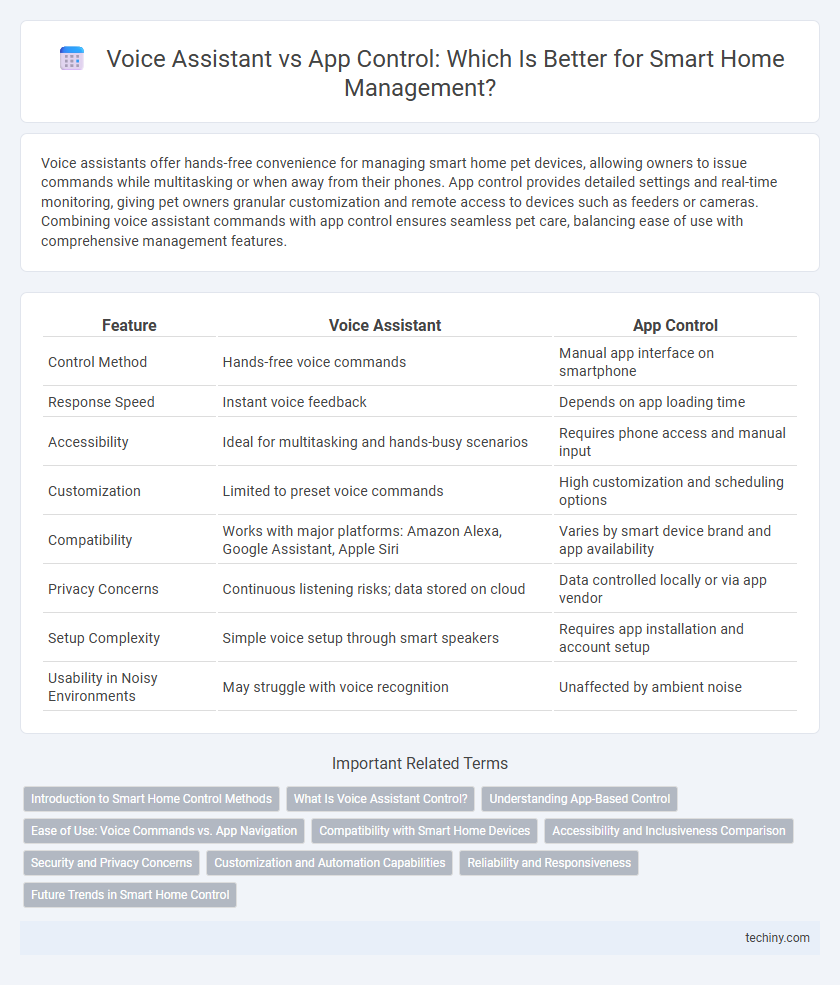Voice assistants offer hands-free convenience for managing smart home pet devices, allowing owners to issue commands while multitasking or when away from their phones. App control provides detailed settings and real-time monitoring, giving pet owners granular customization and remote access to devices such as feeders or cameras. Combining voice assistant commands with app control ensures seamless pet care, balancing ease of use with comprehensive management features.
Table of Comparison
| Feature | Voice Assistant | App Control |
|---|---|---|
| Control Method | Hands-free voice commands | Manual app interface on smartphone |
| Response Speed | Instant voice feedback | Depends on app loading time |
| Accessibility | Ideal for multitasking and hands-busy scenarios | Requires phone access and manual input |
| Customization | Limited to preset voice commands | High customization and scheduling options |
| Compatibility | Works with major platforms: Amazon Alexa, Google Assistant, Apple Siri | Varies by smart device brand and app availability |
| Privacy Concerns | Continuous listening risks; data stored on cloud | Data controlled locally or via app vendor |
| Setup Complexity | Simple voice setup through smart speakers | Requires app installation and account setup |
| Usability in Noisy Environments | May struggle with voice recognition | Unaffected by ambient noise |
Introduction to Smart Home Control Methods
Voice assistants such as Amazon Alexa and Google Assistant enable hands-free control over smart home devices through natural language commands, enhancing user convenience. App control offers a centralized platform on smartphones or tablets for managing lighting, thermostats, and security systems with customizable settings and automation schedules. Integration of both methods provides flexibility and accessibility, optimizing the overall smart home experience.
What Is Voice Assistant Control?
Voice assistant control allows users to manage smart home devices through spoken commands using AI-powered platforms like Amazon Alexa, Google Assistant, or Apple Siri. This hands-free interaction enhances convenience by enabling quick adjustments of lighting, thermostats, security systems, and entertainment without manual input. Voice recognition technology ensures personalized responses and seamless integration with various smart home ecosystems for an intuitive user experience.
Understanding App-Based Control
App-based control in smart homes offers granular customization by leveraging detailed user interfaces, allowing precise adjustment of devices such as thermostats, lighting, and security systems. Unlike voice assistants, app controls provide visual feedback and advanced settings, enabling users to monitor energy consumption and create complex automation routines. The integration of mobile apps with cloud services ensures remote access and real-time alerts, enhancing convenience and security for homeowners.
Ease of Use: Voice Commands vs. App Navigation
Voice assistants enable seamless control of smart home devices through natural language, reducing the learning curve compared to app navigation. App control often requires users to locate specific features within menus, which can be time-consuming and less intuitive. Voice commands offer hands-free operation, enhancing accessibility and convenience for all users.
Compatibility with Smart Home Devices
Voice assistants offer broad compatibility with a wide range of smart home devices from various manufacturers, enabling seamless control through natural language commands. App control typically requires individual apps or a unified platform, which can limit device interoperability compared to voice assistants. Devices supporting popular voice assistants like Amazon Alexa, Google Assistant, and Apple HomeKit ensure enhanced integration and user convenience across diverse smart home ecosystems.
Accessibility and Inclusiveness Comparison
Voice assistants provide hands-free control, making smart home technology more accessible for individuals with mobility impairments or visual challenges. App control offers customization and detailed settings, but can be less intuitive for users with limited tech experience or dexterity issues. Combining both voice and app interfaces enhances inclusiveness, accommodating diverse user needs and preferences in smart home environments.
Security and Privacy Concerns
Voice assistants in smart homes pose potential security risks due to always-on microphones and vulnerabilities to voice spoofing attacks. App control offers more granular permission settings and typically requires user authentication, reducing unauthorized access risks. Both methods require robust encryption and regular updates to safeguard user privacy and prevent data breaches.
Customization and Automation Capabilities
Voice assistants in smart homes offer hands-free control and seamless integration with various devices, enhancing customization through voice commands and routines tailored to individual preferences. App control provides granular customization options and detailed automation settings, allowing users to schedule, monitor, and manage devices with precise configurations. Combining both methods maximizes automation capabilities, ensuring a personalized and efficient smart home experience.
Reliability and Responsiveness
Voice assistants offer hands-free convenience with near-instant response times, enhancing real-time control of smart home devices. App control provides more detailed customization options but can suffer from latency due to network dependencies and device compatibility issues. Reliability in voice assistants depends heavily on microphone quality and natural language processing accuracy, while apps rely on stable internet connections and software updates to maintain consistent performance.
Future Trends in Smart Home Control
Voice assistant technology is rapidly advancing with natural language processing improvements enabling more intuitive and personalized smart home interactions. App control continues to evolve through enhanced user interfaces and integration of AI-driven automation, offering granular customization and remote access. Future trends indicate a convergence of voice and app controls, leveraging multimodal inputs for seamless, context-aware smart home management.
Voice Assistant vs App Control Infographic

 techiny.com
techiny.com